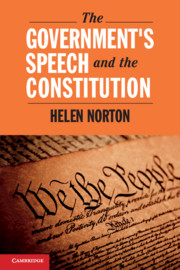Book contents
- The Government’s Speech and the Constitution
- Cambridge Studies on Civil Rights and Civil Liberties
- The Government’s Speech and the Constitution
- Copyright page
- Dedication
- Contents
- Acknowledgments
- Introduction
- 1 Determining Whether and When the Government Is Speaking (and Why That Matters)
- 2 The Government’s Speech and Religion
- 3 The Government’s Speech and Equality
- 4 The Government’s Speech and Due Process
- 5 The Government’s Speech, Free Speech, and a Free Press
- 6 The Government’s Speech and Political Contests
- 7 Responding to The Government’s Destructive Speech
- Conclusion
- Index
1 - Determining Whether and When the Government Is Speaking (and Why That Matters)
Published online by Cambridge University Press: 12 August 2019
- The Government’s Speech and the Constitution
- Cambridge Studies on Civil Rights and Civil Liberties
- The Government’s Speech and the Constitution
- Copyright page
- Dedication
- Contents
- Acknowledgments
- Introduction
- 1 Determining Whether and When the Government Is Speaking (and Why That Matters)
- 2 The Government’s Speech and Religion
- 3 The Government’s Speech and Equality
- 4 The Government’s Speech and Due Process
- 5 The Government’s Speech, Free Speech, and a Free Press
- 6 The Government’s Speech and Political Contests
- 7 Responding to The Government’s Destructive Speech
- Conclusion
- Index
Summary
This chapter examines the Court’s government speech docket to date, which has focused on disputes that require it to determine when the government itself is speaking and when it is instead regulating others’ speech. It explains how the constitutional rules for the government as regulator of others’ speech differ from those that apply to the government as speaker: when the government itself is speaking, then the Free Speech Clause constraints on the government as regulator do not apply. It then offers a framework for approaching these problems that emphasizes the value of transparency—that is, an insistence that the governmental source of a message be transparent to the public as a condition of claiming the government speech defense to a Free Speech Clause challenge. It then applies the transparency principle to difficult first-stage problems to come that will require courts to unravel competing governmental and nongovernmental claims to the same speech, to determine when an individual government official speaks as the government or instead as a private citizen, and to ascertain when an individual public employee’s speech is the actually the government’s to control.
Keywords
- Type
- Chapter
- Information
- The Government's Speech and the Constitution , pp. 27 - 67Publisher: Cambridge University PressPrint publication year: 2019



